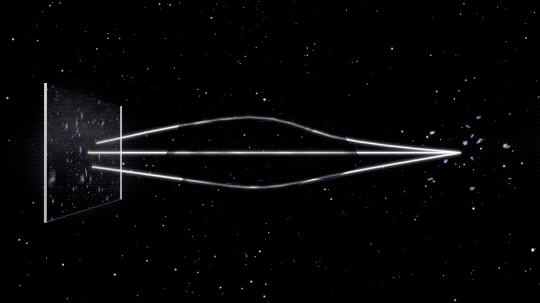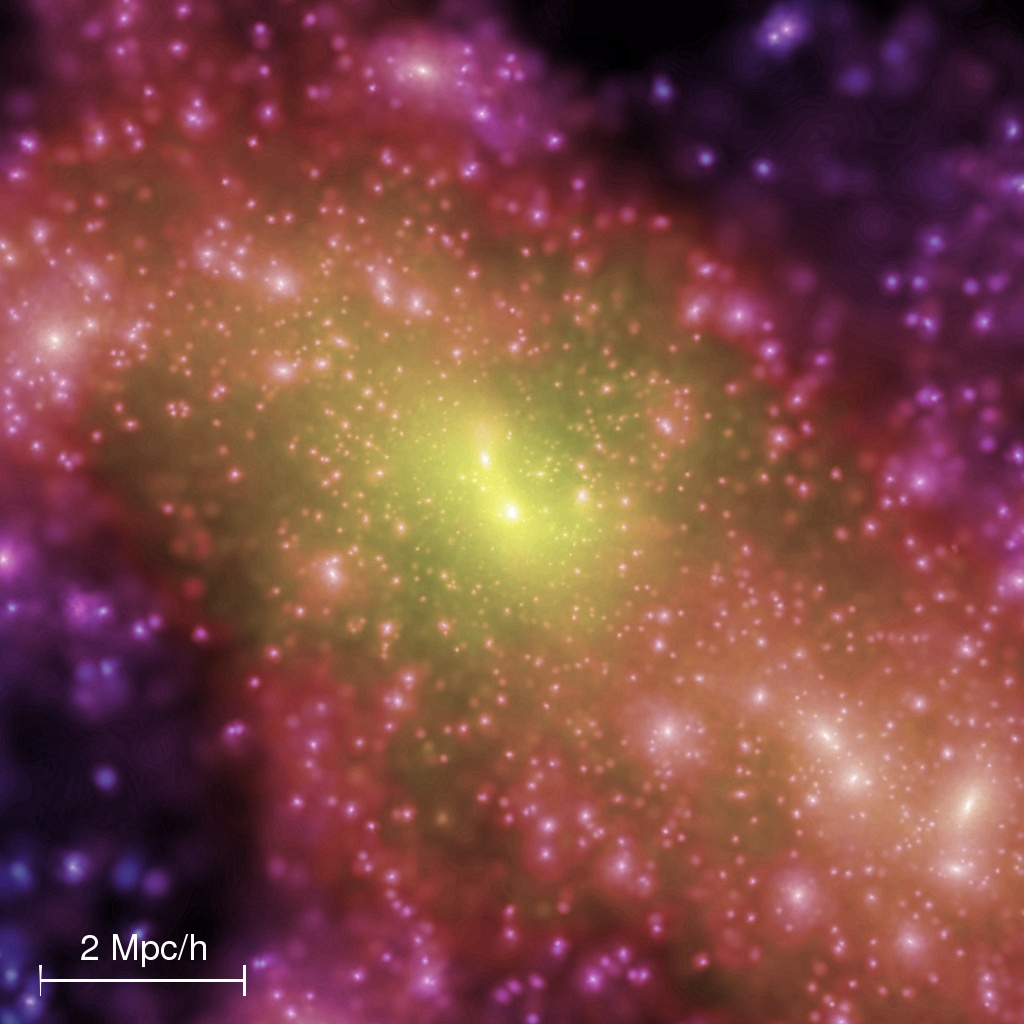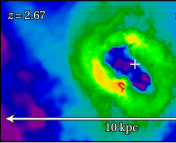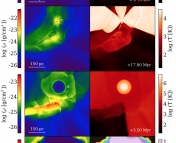Title: The second data release from the European Pulsar Timing Array: V. Implications for massive black holes, dark matter and the early Universe
Authors: J. Antoniadis, P. Arumugam, S. Arumugam, et. al.
First Author’s Institution: Foundation for Research and Technology – Hellas, Greece
Paper Status: Submitted to Arxiv [Open Access]

Last month, astronomers with the North American Nanohertz Observatory for Gravitational Waves (NANOGrav) and many international collaborations announced evidence for the first detection of the Gravitational Wave Background (GWB). If this isn’t the first article you’ve read on Astrobites (if it is, hello!), you’ve undoubtedly heard of gravitational waves, ripples in spacetime caused by the acceleration of massive objects. These waves were first detected by listening for the coalescence of a black hole binary: as these objects spiral towards their fate they release a short burst of high-frequency (around 100 Hz) GWs. The GWB, however, is constant rather than a burst and is comprised of many overlapping low-frequency (measured in nanoHz) sources merging into a muddled hum. Think of it as being in a crowded room: you can hear the sound of many conversations around you, but you probably can’t make out any words unless they are quite nearby. The authors used 15 years of data from a Pulsar Timing Array (see Figure 1) to find the GWB, comparing the arrival times of light signals from pulsars to search for subtle warping of spacetime caused by gravitational waves. What is the primary cause of the background? In the astrobite on the main announcement paper, (that astrobite is straight from the horse’s mouth: written by NANOGrav scientists!) they discuss how merging supermassive black holes are likely causing this signal. In this astrobite, we will delve deeper into the other possible contributing sources and determine what the GWB can tell us about dark matter and possibly new, “beyond the standard model” physics.
Inflationary Gravitational Waves

The universe is hypothesized to have gone through a period of extremely fast expansion at the very beginning of its life, a phenomenon called inflation. The tiny universe was full of quantum fluctuations: the very fabric of spacetime was wiggling thanks to the uncertainty described by the Heisenberg Uncertainty Principle. When the universe absolutely exploded in size during inflation, these quantum wiggles in spacetime were expanded to cosmological scales (See Figure 2) and could propagate as gravitational waves. Could these inflationary GWs be contributing to the GWB? To answer this question, the authors turn to a much more studied background, the cosmic microwave background (CMB). Looking at the CMB, it is nearly “scale invariant” meaning that its level of clumpiness is about the same regardless of how zoomed in or out you look at it. This agrees well with the predictions of our models of inflation, which also predict that the clumpiness of the universe should be roughly the same at all scales. However, the authors determine that the power spectrum (the power spectrum describes how the total power of a signal is distributed amongst different frequencies, for example, a high-pitched sound will have a power spectrum peaking in high frequencies) of the GWB does not match this observation. If you prefer numbers, the spectral index (nT) is a parameter measuring how much clumpiness varies with scale. Current inflationary models predict nT should be about 0, while the GWB implies it would be about 2.7 if the GWB were due to primordial gravitational waves. The authors note that this is unsurprising, if inflationary gravitational waves do exist, their frequencies are likely out of reach of both current and planned GW detectors. But early universe fans need not fret! The CMB still offers a wealth of information on the early universe. In fact, the Simons Observatory, a next-generation CMB telescope, will be able to search for the imprint of these inflationary gravitational waves on the CMB with ten times more precision than we can currently.
Cosmic Strings

String theory is a favorite topic of popular science media, but is confusingly completely different from what we mean by cosmological strings. While the strings of string theory are minuscule, cosmic strings would be, well, cosmic in size, potentially stretching the length of the observable universe. These arise from phase transitions in the early universe. A phase transition is when a system changes phases, such as water freezing into ice or evaporating into steam. Cosmologists believe the universe underwent similar transitions in its early history on a grand scale. However, in the same way that water does not freeze instantaneously, these phase transitions began in specific places in the universe and spread out as “nucleation bubbles”, (See Figure 3). Cosmic strings may form when these bubbles intersect as a kind of leftover “kink” from where the bubbles collide. These strings would be extremely thin (less than the width of a proton) but also very massive. And where there is mass, there is gravity, which is why astrophysicists hope to observe these strings through their gravitational effect on the surrounding universe. If these strings exist, they may release gravitational waves when they get tangled (forming loops or cusps) or collide with one another. Like a normal string, these cosmic strings have a tension, denoted Gμ. The higher the tension, the easier it would be to detect their gravitational waves. The authors consider two models for the GWs released by these strings which depend on their tension and how many kinks they form. The authors find that if strings are a source of the GWB, it means that the logarithm of their tension value is likely between -11 and -9.5. This means that the GWB is consistent with the signal we would expect from cosmic strings under these tensions (see Figure 4), but does not prove that the strings are a source. It does, however, give us a window of Gμ values that we should be looking for in future experiments. This could be promising, as future spaceborne gravitational wave detectors (like LISA, which will observe in a slightly higher frequency range compared to NANOGrav) could detect GWs from strings with tensions with log(Gμ) as low as -17. Time will tell if LISA can spot these spindly giants!

Ultra Light Dark Matter

Finally, the authors seek if the GWB can tell us anything about the nature of dark matter in our galaxy. We know that dark matter must be present due to its effects on the surrounding universe, but we are still unsure what it is made of. Leading models of dark matter do well at explaining the effects of dark matter on the universe at large scales but not small scales, such as failing to describe the rotation curves of some galaxies (the core-cusp problem) or predict the number of nearby dwarf galaxies (missing satellite problem). These problems could be solved if the dark matter was very light. Continuing astrophysicists’ proud tradition of being terribly unimaginative at naming things, these hypothetical particles would be called ultra-light dark matter, or ULDM. Some bounds on the masses of ULDM particles have been set by CMB or Lyman-ɑ experiments (studying where light is absorbed by matter to estimate amounts of matter in the universe), and the authors set out to determine if the GWB produces similar measurements. A recent paper showed that the gravitational wells formed by the ULDM particles would affect the arrival times of pulsar radio beams, and hence affect the measurements of the pulsar timing arrays that were used to detect the GWB in the first place. The wave-like nature of the particles, which have an incredibly long DeBroglie wavelength due to their small mass, is hypothesized to introduce a periodic displacement into the measurements of the GWB. When searching for ULDM alone, the authors find evidence of a very light (10^-23 eV) particle, but when doing a combined search for ULDM and supermassive black hole binary mergers, the need for a ULDM particle disappears. The authors conclude that it is unlikely that there is evidence of a ULDM particle in the GWB.
What’s Next?
The authors predict that with more time and more data, it will become clearer and clearer what the true source of the GWB is. They note that these further efforts will be key in unraveling if any of the GWB is due to the more exotic sources listed in this astrobite. The field of gravitational wave astronomy is incredibly new, and already producing fascinating results. The discovery and analysis of the GWB has unlocked a new wealth of knowledge on top of the already incredible discovery of gravitational waves, and will likely be instrumental in furthering our understanding of the early universe and possibly even new physics!
Astrobite edited by: Megan Masterson
Featured image credit: NANOGrav/Sonoma State University/Aurore Simonnet




